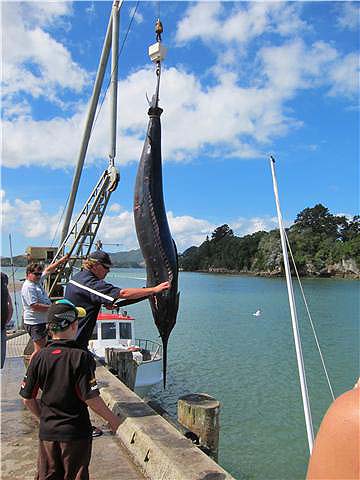

Catch Fish with
Mike Ladle
Information Page
SEA FISHING
For anyone unfamiliar with the site always check the FRESHWATER, SALTWATER and TACK-TICS pages. The Saltwater page now extends back as a record of over several years of (mostly) sea fishing and may be a useful guide as to when to fish. The Freshwater stuff is also up to date now. I keep adding to both. These pages are effectively my diary and the latest will usually be about fishing in the previous day or two. As you see I also add the odd piece from my friends and correspondents if I've not been doing much. The Tactics pages which are chiefly 'how I do it' plus a bit of science are also updated regularly and (I think) worth a read (the earlier ones are mostly tackle and 'how to do it' stuff).
Plastic fantastic!
Now for some real sea angling - not mine but proper saltwater nonetheless. My Pal Alan, in New Zealand, has just been on a bit of a holiday and he sent me a nice little diary written in his own inimitable style - wonderful stuff! For any sea angler, anywhere in the world, there's a wealth of interesting stuff about using soft plastic jigs. I'm going to have a holiday myself but this should keep any blog readers going 'til I get back. Here goes -
Hi Mike,
I guess that you’ve probably already gone to Tobago but in case you haven’t I’ll briefly summarise the last few weeks fishing at Whangapoua and yesterday on the Waitemata (outstanding). We motored up to Whangapoua on 13 January. The highlight of the 3 hour journey would have to be the massive 'workup' (My mouth's watering! ML) that we witnessed in the Firth of Thames. The sea was a seething mass of fish, dive bombing gannets and fairy terns. The workup covered about 6 football fields in area and there was so much white water that the surface in the middle of the maelstrom seemed to boil up about half-a-metre from the surrounding water. Unfortunately it was about a kilometre offshore so we could not cast a line to it. Nothing eventful happened en route other than a boat trailer tyre puncture but this only took 15 minutes to change and we were able to get it repaired within 10 minutes at the next settlement.
Thursday 14 January was spent visiting a world famous beach (New Chums – see attached picture) with some friends. After a BBQ dinner I took the four adolescents down to the wharf for a spot of fishing on dusk. Colin Clarke crept up behind me on the wharf and brusquely asked if I had a permit to fish there. Cheeky bugger! After a chat we arranged to go fishing the following morning. I had to be at Colin’s house (an arduous 50 metre stroll) at 5.00 am so that we could cross the Whangapoua bar at first light.
SESSION ONE
The next morning dawned calm and fine and we were off to the boat ramp without hesitation. To minimise any potential danger Colin had arranged to travel across the bar with another boat skippered by his friend, Brent, and he was already waiting at the boat ramp with his outboard running when we arrived. Colin and Brent negotiated the bar in the half light without any problems and once over it we split up to fish each skipper’s favourite spot. Cell phones were used to keep in touch and report progress. Colin rigged up a Gulp! Nuclear Chicken on a 5/8 oz. jig head and cast upstream of the drifting boat (drogue attached). There was no stopping him. In two successive casts he winkled out a brace of gurnard while I stared on, mouth agape. It went quiet for a while but our soft baits were continuously getting grabbed and mangled by decent squid before daylight.
A large barracouta was the next fish to seize Colin’s soft plastic and it gave a spirited, albeit sinuous tussle, before being brought boat side for release. I changed my soft plastic to an Orange / Red Sassy shad and finally managed to snare a couple of gurnard. Both fish took the bait as the braid was almost vertical and starting to lift the lure off the bottom. Colin was once again in the action soon after and landed a couple of 34 – 38 cm. Snapper. Respectable but not the “string pullers” we were after. I then got hit by a larger snapper which fought strongly until the hook pulled half way to the surface and finished by landing another snapper which was the mirror image of Colin’s brace. Colin meanwhile managed to winkle out a large John Dory just to add some variety to the fish bin. We moved about trying unsuccessfully to get more fish but once it got to around 8.00 am the fishing was hard so we motored back home for breakfast at 9.00 am.
SESSION TWO
Colin had recently purchased a Gulp! Squid jig (NZ$ 20.00) and was determined to go out the following morning and snare a squid with it. We arranged to meet again in the half light and set off from the boat ramp with Brent at 5.40 am. Unfortunately the bar was a bit more boisterous than the previous morning so we had to wait until there was more light before attempting to negotiate it amongst the swells. Safely through the bar both boats opted for the same routine as the previous morning. I’d rigged up with a clear Squidgy shrimp imitation on a 5/8 oz jig head (see attached) and was into snapper on my first two casts. Respectable 36 cm fish that were ideal table fare. Both fought strongly but did not pull vast swathes of line from the spool. Colin was persevering with the squid jig but getting mighty twitchy by this stage when all of a sudden his line went tight. He called it for a squid early and deftly brought it to the boat where he adeptly scooped up his 35 cm prize with a bucket to prevent being bathed in ink. My Squidgy shrimp imitation was also being constantly scarred by squid tentacles but I was unable to foul hook the culprits.
The next drift my lure got absolutely monstered on the first cast as I was starting to lift it from the bottom. We picked it for a large snapper and it was burning line. After about five minutes of searing runs and angry head shaking I seemed to be making head way when the line broke at the loop knot. I suspect that it got clipped by the sharp edge of a gill plate on one of the snappers original runs and broke due to less stretch on a shorter line. I’ve never had a loop knot fail before. The next cast my line was spanked again but the sinuous head shaking routine spelled barracouta. It was a decent fish at around 8 – 10lb but fought poorly. This signalled the start of a frustrating hour for me as I lost several jig heads to barracouta and every fish I hooked and brought to the boat was from the same clan. Colin on the other hand was pulling in snapper like a machine and seemed to boat a 36 cm fish on every drift. When he hooked a barracouta he always landed it and never seemed to be bitten off. The main difference between our rigs was that Colin was using a simple line clip rather than a loop knot. My gut feeling is that the extra length afforded by the clip made it difficult for the barracouta to reach the line, hence the reduced break offs. We moved around a bit trying to avoid barracouta and eventually managed to catch a couple of gurnard each to round off the morning.
Brent is a bait fishing specialist and will not have lures on his boat. Brent and his fishing partners caught roughly the same number of fish as Colin and I but nowhere near the variety or size. Snapper (30 – 34 cm.) made up the bulk of their daily catch.
Later in the day Hamish and Tim went snorkelling near a rocky headland adjacent to the Bach we were staying in and returned with 16 plump Green-lipped mussels. None of the mussel shells was smaller than 8” (That's what I call a mussel ML). We microwaved them to open their shells, applied salt, brown sugar and the odd accompaniment (Sweet Chilli sauce or Soy sauce and garlic) before hot smoking them in the half shell for lunch. In 15 minutes they were ready to eat with some crusty bread. Stunning! (see photograph). Later that evening we adjourned to Colin and Leith’s house for “Clarke's takeaways”. Fresh fish and chips with crumbed squid rings served with a green salad and a chilled Sauvignon blanc. Colin did himself proud on the frying. “Best we’ve ever had”! (My mouth's watering again! ML)
SESSION THREE
The next day we went out on our own later in the morning (10.00 am) and Colin helped us negotiate the bar. We only had time for a couple of drifts before the bar would be impassable due to low tide but we managed to snare three gurnard and a 34 cm snapper for dinner. I got two gurnard on the Squidgy shrimp and Sandy nailed the rest on cut pilchard bait. Neither Hamish not Tim troubled the scorers. Again the largest fish fell to the soft plastic.
SESSIONS FOUR – SIX
The weather took a turn for the worse over the next four days which made the Whangapoua bar impassable so I was forced to fish in the Whangapoua estuary from the shore. The estuary itself screamed fish (see attached photograph). Clear water, sandy bottom interspersed with the occasional weed covered rock and generally deep channels. I saw numerous kahawai up to 2 lb and a massive pack attack on bait fish late one afternoon but was unable to find the key to catch more than a couple of fish. I tried hard bodied lures (bibbed and bibless) and soft plastics of every description all to no avail. There was a lot of boat traffic and bathers in the sections that I fished and I suspect that this forced the fish into the deeper more inaccessible holes on the far side of the channel. Another interesting feature of the estuary was the huge numbers of starfish scattered widely across the bottom in the margins. I’ve never seen the like before and maybe this was another factor in the lack of fish?
In one outing I managed to foul hook a parore. Parore are avowed vegetarians that grow up to 10 lb. The Australians call them luderick (or blackfish). They inhabit the rocky margins and can be targeted using sea lettuce (suspended under a float) or on rare occasions by using raw shellfish such as pipi or cockles. I was fishing a section of the estuary near the headland where the outgoing current was forced against a sheer rock wall festooned by weed. As I retrieved the Yo-Zuri 3D vibe up the sheer face the lure paused and I struck hard. The lure was only about two rod lengths away and the parore, which would have weighed 4 lbs, came quickly to the surface where it was photographed and released. They are beautiful fish and when lip hooked fight doggedly - like snapper.
I missed fishing one day due to the steady rain and strong gales. We took the opportunity to travel down the Coromandel Peninsula and check out the beaches at Otama and Opito Bay. We eventually reached Whitianga after stopping in to see a knife maker. The “bladesmith” made his knives from old coil truck springs using a forge and anvil. It took three days to make one knife and they were works of art. Each had a different handle made from native timber and the standard of finish was exemplary. We got to Whitianga wharf just in time to see a 170 lb Blue Marlin being weighed. It was caught on 15 kilogram tackle so was a meritorious capture (see attached). It is such a shame to see such magnificent fish hanging from a weigh masters gantry.
SESSION SEVEN
One of the features of the Coromandel are the mussel and oyster farms. Most of the farms are located on the western side and they are major undertakings. Growth rates are phenomenal and it only takes 12 months for spat to reach saleable size. Harvesting occurs daily and each 100 metre set generally yields around 45 MT of mussels. The mussel farming companies allow recreational fishermen to fish for snapper in the mussel farms in an effort to minimise spat mortality. They need snapper to thin the spat but not clear the ropes of mussels. There are several companies that specialise in fishing the mussel beds using modified mussel barges. The best time to fish is when the mussels are being harvested but there are snapper holding in amongst the ropes constantly.
We were keen to sample fishing in the mussel farms so arranged a trip out one evening. It took around 25 minutes to journey across to Coromandel town from Whangapoua on a highway that is best described as “circuitous”. In fact, circuitous is an understatement as there were more hairpins on this road than could have been found on a typical Edwardian dresser! The barge left the wharf at 4.00 pm for the 35 minute trip at 8 knots to the mussel farm. Upon reaching the farm the charter boat skipper simply drove bow first into the mooring ropes and attached a sturdy grapnel to the uppermost rope. This held the barge perpendicular to the ropes and allowed the passengers to fish the channel between successive ropes. Burley was dispensed and within 2 minutes the patrons were hauling in snapper in a seemingly endless stream. Unfortunately they were mostly undersized and a legal fish appeared every 20 snapper or so. There were no complaints as the action was full on. Interestingly I was fishing with soft baits and was not troubled by small snapper at all. In fact, nothing at all was interested in munching rubber.
The skipper decided that he was going to lob in a half slab of mackerel on a stray line to see if he could winkle out a larger snapper. He cast the bait out as far as possible from the barge and made sure that the bait drifted down the water column as close as possible to the mussel ropes. I watched the line descend through the depths and saw the line tighten savagely. The skipper struck hard and the snapper hit the afterburners. It was all over in seconds. The taut nylon rubbed against the mussels and the large snapper easily won its freedom. Seeing this, and sensing that imitation was the sincerest form of flattery, I quickly rigged a larger Gulp! Stickbait (4”)onto a ½ oz jig head and lobbed it as close as possible to the ropes. The soft bait drifted slowly down the water column to the bottom. It only got ¾ of the way to the bottom before it was absolutely monstered. I fumbled the bail flip and it took seconds to come up tight and set the hook hard. By then the taut braid was rubbing over the ropes and shaving the detritus off the mussels. Luckily the fish stopped when it felt the full force of the drag and I was able to wrestle it away from its safe haven. Once away from the ropes it fought hard but was no match for the soft bait tackle and was soon drawn inexorably to the surface. At 4lbs it was a nice fish and easily the largest boated during the trip (see photograph - if you look closely you can see the large black floats of the mussel farms in the background).
Circumstances prevented me from repeating the process. A steady procession of fish nipped the tails off all of my remaining Gulp! Soft baits, the ground bait ran out (and so did the bite) and I could not stop any fish that I hooked from cutting me off on the mussel ropes. The barge moved a couple of times but the fishing tapered off as the sun set. Hamish hooked an XOS snapper which ran him right around the boat before dragging him into the ropes for the mussels to shear the nylon. At no point was he in control of the fish. Hamish was fishing with a “stump puller” rod, braid, 60 lb nylon trace and around 6 lbs of drag but the fish treated this with complete disdain. Tim caught fish on every drop and must have set some sort of record for the number of snapper “Caught and Released” in a session. We ended up bringing 8 fish home ranging between 35 – 44 cm.
SESSION EIGHT
On arriving back in Auckland and checking the weather forecast, Tim and I decided to head out for a morning fish on the Waitemata yesterday. The day dawned clear, still and warm. There were clouds massing on the horizon but these did not detract from the beauty of the morning. We headed out from the boat ramp at 8.40 am after acquiring some pilchards as bait (for Tim) and a large bag of salt ice for the chilly bin. As we came out from the marina onto the Waitemata I noticed the distinctive shape of Intrigue moored near Peter’s 'never fail spot' so we motored over for a chat. Peter had been fishing the outgoing tide for around 1 hour with bait and they had 4 fish in the bin with the largest snapper being 48 cm (~ 5 lb).
We decided to head out into the Rangitoto channel and drift out with the tide along the side of the main navigation channel. Reaching our start point I threaded on a Zoom White Ice ( ½ oz jig head) and lobbed it upstream of the boat. Tim started to rig up his rod and before he could attach the hooks I was fast into a hard running snapper. The fish pulled string from the outset but quickly relented to the endless pressure and was brought to the boat for Tim to net. It was a nice fish of around 2 ½ lbs and was despatched to keep the salt ice company.
I checked the soft bait, re-adjusted its position slightly and cast about three rod lengths ahead of the boat. Tim went back to his seat and picked up where he had left off. The lure would not quite have reached the bottom when it was absolutely spanked by a much better snapper. I struck back hard and line poured from the spool as the reel howled in protest. The 7’ dropshot rod was bent like a staple and clearly enjoying the workout. This fish was definitely not happy and was shaking its head aggressively in resistance. After a while I was able to pump some line back onto the spool only to have it dragged back off in short order. The “to-ing and fro-ing” continued for about 5 minutes before the fish yielded and was drawn to the surface for Tim to net. At 52 cm (6 lb) it was a fine specimen and ideal table fare.
The Zoom soft bait was now knackered so I replaced it and quickly lobbed the lure ahead of the drift of the boat. Again Tim went back to his seat and before he could express air from the cushioning I was hooked up on another hard charging fish. I gave the rod to Tim to play the fish and he unluckily lost it close to the boat. Fortunately the lure was not damaged so I cast it out again which we returned to staring positions. Tim still had not got his line into the water! This pattern was to continue for some time as I was hooking up on every cast. Tim landed the next two fish (5 lb and 4 lb) after both had pulled lots of line from the reel on their first scorching runs. The muscles in his arms were aching pleasantly from his exertions and he was clearly enjoying himself. Eventually he was able to get his baited line to the bottom but the hooks were hoovered clean immediately. By now it was time to retrace our drift so Tim gave up bait fishing for soft baiting. “The door has finally inched open and light is streaming through”.
We fished for about 2 hours in total and kept 6 fish (largest 6 lb, 2 @ 5lb, 2 @ 4 lb and 1 @ 2 ½ lb). Tim managed to eventually catch a 5 lb fish on his own account on soft bait and he was stoked. Brilliant fun, top day on the water. Peter landed 11 fish between 8 and 12.30 pm on bait with the largest being a 48 cm (5 lb) specimen. Once again soft bait caught the largest fish. Unfortunately I had a camera malfunction so had to take the attached shot of the fish in the bin using my mobile phone.
Trust that you are all well and enjoy your holiday.
All the best. Tight lines!
Alan Bulmer.
Shortly after his long email Alan wrote to me again.
Hi Mike,
Here are a few more pictures. The fishing overall has been very good. Nothing huge but excellent quality. I was a bit disappointed with the lack of action in the Whangapoua estuary as there were some beautiful holding lies. Most days I had to contend with ignorant oiks towing their children flat out on ski biscuits in the 5 knot maximum navigation channels (Obviously it's not just in the UK that there are idiots! ML). Too remote to have harbour wardens policing the maritime regulations. Beautiful spot all the same. Shame Colin was only there for 3 days of our holiday. In hindsight I should have borrowed one of the boys kayaks and gone for a paddle.
The Waitemata is going off so I’m trying hard to get someone to go out again with me over the long weekend. Wednesday's session was amongst the best I’ve experienced. Tim was gobsmacked at how effective lures can be when the fish switch on. I had 5 fish on consecutive casts which is phenomenally good fishing.
I tried a clip to attach the soft bait on the Waitemata harbour on Wednesday without success. My feeling is that it inhibits the soft bait action more than a loop knot and I’m prepared to lose the odd fish if I’m hooking more. 7 fish on a loop versus 0 on the clip says it all.
We saw two free jumping Mako sharks while on holiday (one at Whangapoua with Colin and one in amongst the mussel farm). 6' of cart wheeling shark is an awesome sight.
Enjoy Tobago. Tight lines and best wishes to all,
Alan.
So, if you have never used soft plastics for sea angling it's probably time you gave them a try. Shads are not the only SPs worth a go and I suspect that if we did a bit more jigging we would catch a much greater variety of fish.
If you have any comments or questions about fish, methods, tactics or 'what have you!' get in touch with me by sending an E-MAIL to - docladle@hotmail.com
Whangapoua estuary.
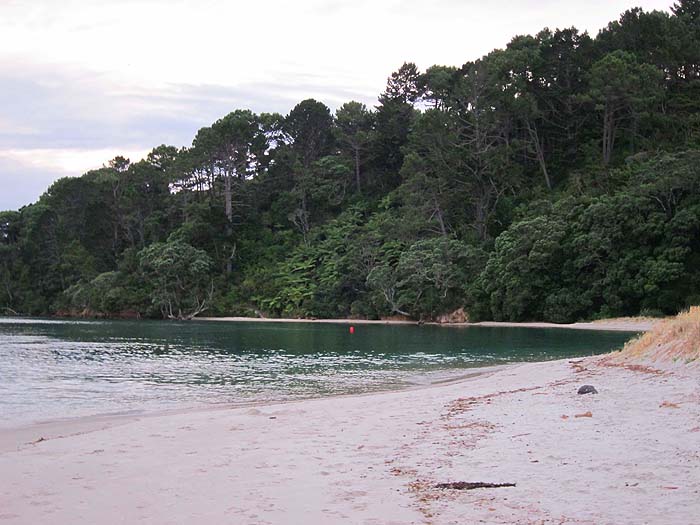
Nice beach!
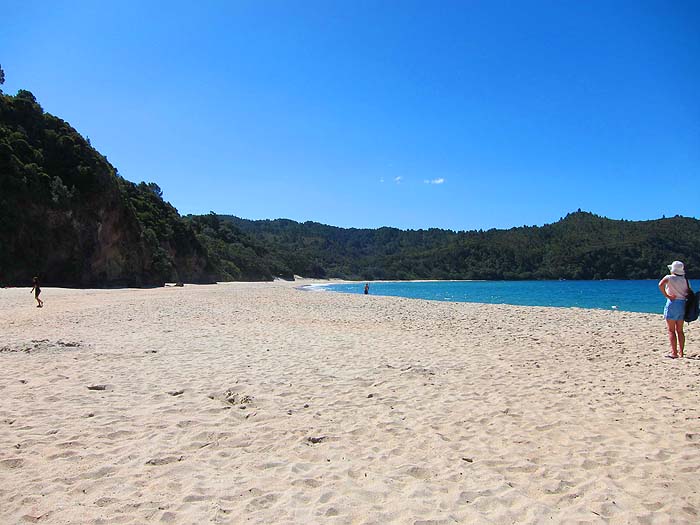
Eight inch mussels.
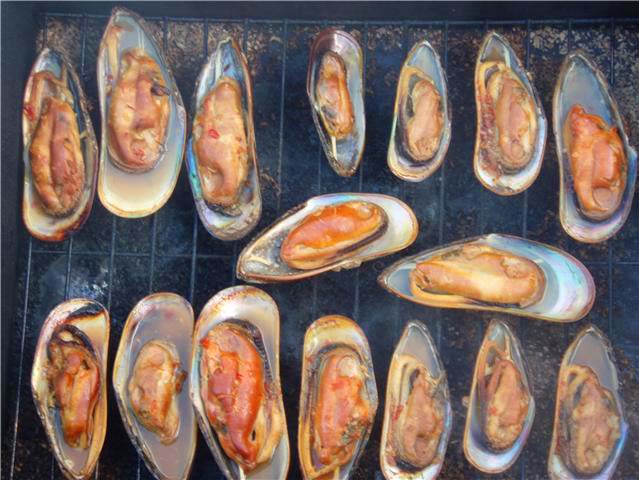
Parore.
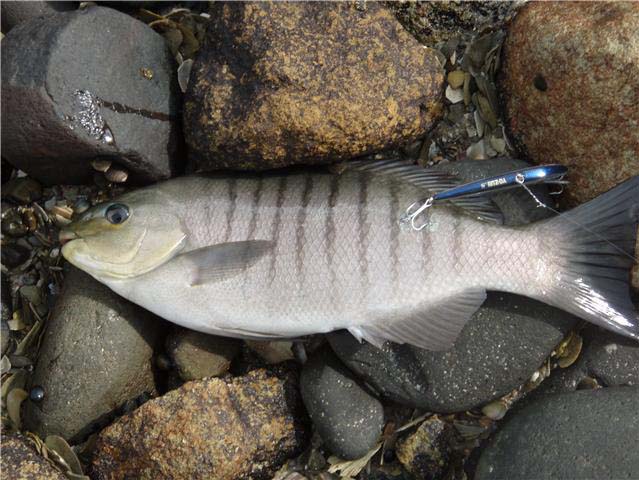
Snappers.
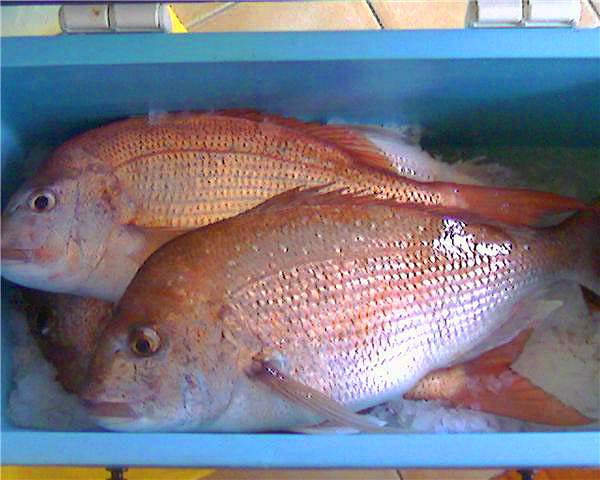
Beautiful fish.
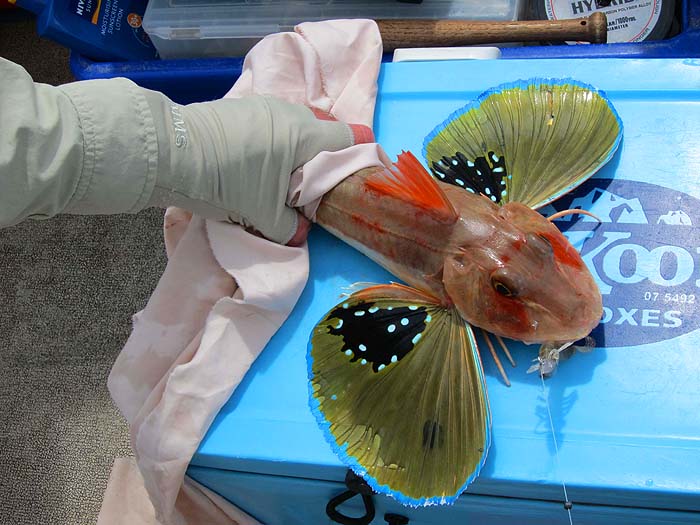
Nice snapper.

Marlin.
